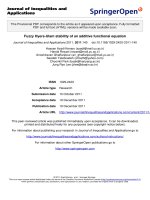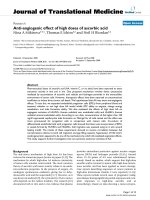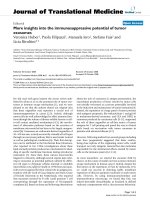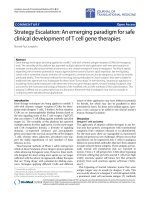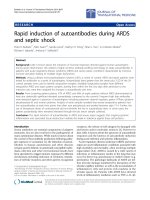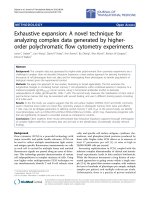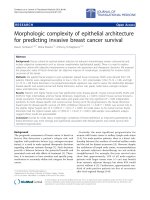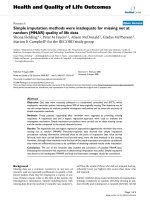báo cáo hóa học:" Inverted ''''V'''' osteotomy excision arthroplasty for bony ankylosed elbows" pptx
Bạn đang xem bản rút gọn của tài liệu. Xem và tải ngay bản đầy đủ của tài liệu tại đây (2.68 MB, 24 trang )
This Provisional PDF corresponds to the article as it appeared upon acceptance. Fully formatted
PDF and full text (HTML) versions will be made available soon.
Inverted 'V' osteotomy excision arthroplasty for bony ankylosed elbows
Journal of Orthopaedic Surgery and Research 2011, 6:60 doi:10.1186/1749-799X-6-60
Chandrabose Rex ()
Rameshkumar Periyasamy ()
Subbachandra Balaji ()
Premanand C ()
Shreyas Alva ()
Shiva Reddy ()
ISSN 1749-799X
Article type Research article
Submission date 12 February 2011
Acceptance date 5 December 2011
Publication date 5 December 2011
Article URL />This peer-reviewed article was published immediately upon acceptance. It can be downloaded,
printed and distributed freely for any purposes (see copyright notice below).
Articles in Journal of Orthopaedic Surgery and Research are listed in PubMed and archived at
PubMed Central.
For information about publishing your research in Journal of Orthopaedic Surgery and Research or
any BioMed Central journal, go to
/>For information about other BioMed Central publications go to
/>Journal of Orthopaedic Surgery
and Research
© 2011 Rex et al. ; licensee BioMed Central Ltd.
This is an open access article distributed under the terms of the Creative Commons Attribution License ( />which permits unrestricted use, distribution, and reproduction in any medium, provided the original work is properly cited.
Inverted 'V' osteotomy excision arthroplasty for bony ankylosed elbows
Chadrabose Rex, Rameshkumar Periyasamy, Subbachandra Balaji, Premanand C, Shreyas
Alva, and Shiva Reddy
Affiliation:
Department of orthopaedics,
Rex Ortho Hospital
Number 43 , RR Layout
Coimbatore 641045
India
E mail addresses:
Chadrabose Rex :
Rameshkumar Periyasamy :
Subbachandra Balaji :
Premanand C :
Shreyas Alva :
Shiva Reddy :
Abstract:
Background: Bony ankylosis of elbow is challenging and difficult problem to treat. The
options are excision arthroplasty and total elbow replacement. We report our midterm
results on nine patients, who underwent inverted 'V' osteotomy excision arthroplasty in our
hospital with good functional results.
Materials: Our case series includes 9 patients (seven males and two females) with the mean
age of 34 years (13-56 years). Five patients had trauma, two had pyogenic arthritis, one had
tuberculous arthritis, and one had pyogenic arthritis following surgical fixation.
Results: The average duration of follow up is 65 months (45 months-80 months). The mean
Mayo`s elbow performance score (MEPS) preoperatively was 48 (35-70). The MEPS at final
follow up was 80 (60-95). With no movement at elbow and fixed in various degrees of either
flexion or extension preoperatively, the mean preoperative position of elbow was 64
0
(30
0
to 100
0
). The mean post operative range of motion at final follow up was 27
0
of extension
(20-50
0
), 116
0
of flexion (110
0
-130
0
), and the arc of motion was 88
0
(80
0
-100
0
). One patient
had ulnar nerve neuropraxia and another patient developed median nerve neuropraxia, and
both recovered completely in six weeks. No patient had symptomatic instability of the
elbow. All patients were asymptomatic except one patient, who had pain mainly on heavy
activities.
Conclusion: We conclude that inverted 'V' osteotomy excision arthroplasty is a viable option
in the treatment of bony ankylosis of the elbow in young patients.
Introduction:
Bony ankylosis of elbow is not uncommon. The conditions causing bony ankylosis are
trauma, head injury, inflammatory arthritis, infection, burns, and neurological conditions,
like hemiplegia, anterior poliomyelitis, and idiopathic [1-5] . The challenge lies in treating
such patients as the options are limited and are associated with complications. The total
elbow arthroplasty (TEA) is increasingly done for various conditions of the elbow including
bony ankylosis[6,7]. TEA in elbow is associated with high complication rate, which varies
from 26 % in ankylosed elbows[6] to as high as 44%[8] , in elbows with various etiologies.
Though the complications rates are decreasing in TEA, the consequences secondary to
complications are far reaching and are difficult to address[9] . Thus neither the cost of the
implants, and nor the high complications associated with TEA has made it popular in
developing countries. Many authors have used excision arthroplasty [10,11] to regain
functional motion in ankylosed and stiff elbows. We used a modified excision arthroplasty,
where we resected the bone in inverted v shape, to treat our patients. The objective of our
case series is to analyze the functional outcome and the complications associated with our
modified excision arthroplasty for bony ankylosis of the elbow.
Patients and methods: From 2000-2005, 47 patients with elbow ankylosis were treated in
our hospital. Nine patients had bony ankylosis, and thirty eight, fibrous ankylosis. The
patients with bony ankylosis were included in the study. None of these patients had active
soft tissue or bone infection at the time of the procedure. Five patients had moderate pain
on activity over shoulder girdle, two patients had mild pain, and two patients were
asymptomatic. The primary indication for the procedure is functional restriction of the
patients in seven and both functional limitation and pain in two patients. The cause of the
pain in two patients may be assumed to occur due to the compensatory movements at
adjacent joints or due to post infective and the exact cause is difficult to be elucidated as it
involves the whole of upper extremity inconsistent in location and duration. Thus, all nine
patients with bony ankylosis were treated with inverted “V” osteotomy excision
arthroplasty. Seven were males, and two females. The mean age of the patient was 34 years
(13-56 years). The right hand was involved in four patients and the left hand in five patients.
All were right handed dominant patients. The mean duration of ankylosis before excision
arthroplasty was 7 years (2-15 years). Six patients had at least one previous surgery, with
two patients having had three surgeries prior to the index procedure (table 1).
Operative Technique:
Patients were administered regional anesthesia (scalene block), and put in supine position
with tourniquet control. All patients were operated by combined medial and lateral
approach with two separate mid medial and mid lateral incisions (fig 1 and fig 2).With
medial approach, through the subcutaneous tissue the ulnar nerve isolated and care taken
to preserve brachial vessels as they can change their course with altered anatomy, and the
medial condyle of humerus reached. Throughout the procedure, utmost care taken to stay
subperiosteally and sticking on the supracondylar ridge both anterior and posterior elbow,
to avoid any neurovascular injury. We used gauze piece, made into peanuts, to elevate the
periosteum anteriorly and posteriorly. With lateral approach and similar technique, global
soft tissue release was done all around 360
0
in continuity. The original technique of excision
arthroplasty involved subperiosteal transverse resection at condylar level and some form of
interpositional material was used. In our technique, the bony ankylosed elbow was
osteotomised in an inverted ‘V’ shape(fig 3 and fig 4 and fig 5) at the widest part of the
bone,and no interpositional material was used as they have consistently given poor results
and have carried risk of infection , donor site morbidity and foreign material reactions[12].
After completion of osteotomy, the anterior bony edges were smoothened and beveled
more to increase the flexion of the elbow. Care should be taken to avoid overzealous
excision of bone, to prevent floppy elbow. The bone edges smoothened using a burr with
care to maintain optimum tension of soft tissue. Thus, medial and lateral stability was
maintained because of intact sleeve of soft tissue released globally around the elbow and
the V shaped osteotomy. Maximum flexion and extension obtained by trimming of the bone
edges. All the patients achieved complete arc of flexion and extension intraoperatively. Arc
of rotation also was checked. Two patients underwent excision of radial head who had
limited arc of rotation after the osteotomy. Though many articles suggest many adjunctive
methods of reconstruction during the procedure and stabilization post operatively but the
unique osteotomy allows the joint surfaces to act as a hinge giving good stability and range
of motion and we always believed in patients active involvement in active flexion and
extension excercises which boosted patients energy levels which resulted in early
satisfactory range of motion and comfort. Wound closed in layers with a suction drain after
obtaining hemostasis, after releasing the tourniquet. First generation cephalosporin
(cefazolin) was given as prophylactic antibiotic, one dose preoperatively and two doses
postoperatively, at 8 hourly intervals, for all the patients. Elbow immobilized in 90
0
with
crammer wire splint. Postoperatively, on day 1, controlled range of movement started from
90
0
to full flexion by manually distracting the joint by physiotherapist. Distraction flexion
and extension excersies where patient is taught active flexion and extension with mild
traction and counter traction with the help of physiotherapist. Distraction flexion method
was taught to the patient and encouraged to do on their own. Post operative continuous
regional analgesia in the intra scalene region with the catheter for 3 to 5 days depending on
pain tolerability of the patient, patients were compliant with our exercise program. Sutures
were removed on 12th day. Splint was continued till 3rd week. Progressive extension of the
elbow started after 3 weeks. Until 6 weeks the splint was used as a rest splint.
The range of motion was measured using hand held goniometer. The patients were clinically
evaluated using Mayo`s elbow performance score[13,14] . It consists of four components:
pain (maximum score, 45 points), motion (maximum score, 20 points), stability (maximum
score, 10 points), and daily functional activities (maximum score, 25 points). A score of 90-
100 is considered as excellent result; 75-89,as good result; 60-74, as fair result; less than 60
,as poor result. The data were collected from the hospital medical records. Radiograph
evaluation was done with two views; antero-posterior and lateral views(fig 6 and fig 7). The
Mayo elbow performance score was calculated preoperatively and at final follow up, and
radiographs taken preoperatively and at final follow up were assessed. The mean duration
of follow up was 65 months (45 months -80 months).
Results: The mean preoperative position of elbow was 64 degrees (30
0
to 100
0
) with fixed
elbow in all patients(fig 8). The mean post operative range of motion at final follow up was
27
0
of extension (20
0
-50
0
), 116
0
of flexion (110
0
-130
0
), and the mean arc of motion was 88
0
(80
0
-100
0
) (table 1)(fig 9 and fig10). The arc of rotation increased to an average of 81
0
(supination of 38
0
, pronation 42
0
) from the pre operative value of 47
0
(supination of 23
0
,
pronation 24
0
), with three elbows with fixed rotation gaining mean arc of 41
0
(supination
16
0
, pronation 26
0
).
The mean Mayo`s elbow performance score preoperatively was 48 (35-70). The MEPS at
final follow up was 80 (60-95) (table 2). The improvement in arc of motion and MEPS score
is statistically significant (p<0.001). The heterotrophic ossification (HO) adjacent to anterior
neurovascular structure was left undisturbed, as the patients had intraoperative gain of full
functional range after the osteotomy, to avoid inadvertent injury to neurovascular
structures. It remained static in the final radiograph with no new HO formation. No patient
reported clinical instability though there was some subtle laxity on medial and lateral side
on clinical examination, in comparison with the other normal elbow, that did not affect the
functional activities of the patient and the MEPS. All patients were asymptomatic except
one patient, who had pain mainly on heavy activities. All the patients were satisfied
cosmetically and functionally. One patient had ulnar nerve neuropraxia and another patient
developed median nerve neuropraxia, and both recovered completely in six weeks.
Discussion: Bony ankylosis of elbow is caused by plethora of causes, and remains a difficult
problem to treat. The bony ankylosis of the elbow compromises functional ability of the
arm, and puts greater demand on shoulder, spine, and wrist, as in the case of arthrodesis.
The compensatory movement is more on spine and wrist, rather than the shoulder[15] . The
primary indication for treating these patients is functional disability, though some patients
present with upper limb pain. The challenge lies in treating such patients as the options are
limited and are associated with complications. The options are resection arthroplasty, and
total elbow replacement.
• Various reports are available in the literature regarding the use of excision
arthroplasty for the treatment of ankylosis of the elbow, mainly fibrous ankylosis.
However, the reports are limited for the treatment of bony ankylosis of the elbow,
exclusively. Different kind of materials are interpositioned, such as fascia lata[16] ,
muscle and capsule[17] , fat[18] , dermis[19] , acrylic[20] , nylon, homografts[21] ,
and allografts[22] . The gel foam has been used commonly in two series of excision
arthroplasty[10,23] , and it has been mentioned that the operated limb becomes
heavier for the patient as it adsorbs blood and body fluids. This makes
uncomfortable for the patients and hence great effort is needed from the patient
part to cooperate with post operative mobilization. We have not used any
interpostional material in our patients. The gain in arc of motion after excision
arthroplasty[10,11,24,25] , and total elbow replacement [6,26] for bony ankylosis,
reported in literature have all been significant, and increased the functional activity
of the patient. In our series, the mean post operative range of motion at final follow
up was 27
0
of extension (20
0
-50
0
), 116
0
of flexion (110
0
-130
0
), and the mean arc of
motion was 88
0
(80
0
-100
0
), which is comparable to other series.
The pain was not significant feature in these patients compared to the functional disability.
However, a few patients had mild pain or pain on exertion and they all were able to manage
without affecting functional activity of life[10,11] . In our series, all but one patient had pain,
mainly on heavy activities.
All the patients had perceptible lateral instability in most of the series[10,11] reported on
literature on excision arthroplasty limiting functional activities. In our series, though
patients had subtle medial and lateral instability on clinical examination, no patient
reported functional instability as our surgical technique allows us to maintain global soft
tissue sleeve, and inverted bony V cut provided additional bony stability. So, our technique
provided better results in terms of stability, and better MEPS score. However, the surgical
technique requires meticulous dissection as the anatomy could have been distorted due to
longstanding bony ankylosis. We had one case of ulnar nerve neuropraxia, and another
patient had median nerve neuropraxia. The ulnar nerve has been reported to be involved
commonly in the literature[19,21,24,25] , where as the median nerve involvement is rare.
We possibly had one case of median nerve involvement due to inadvertent force while
retracting during surgery.
Despite high possible risk of recurrence of HO, the benefit of prophylaxis remains subject of
debate in case of elbow. In reported literature on excision arthroplasty, no method of
prophylaxis was used[10,11,23,24,25] . David Ring et al[25] had two cases of recurrence of
complete ankylosis out of 20 cases in their study, which was excised again and prophylactic
radiotherapy was given. Due to limitation of resources, our patients were not given
radiotherapy. In our patients Indomethacin 25 mg thrice a day, along with proton pump
inhibitor, pantaprazole 40 mg once a day, was given for 4 weeks. No patients had
recurrence of heterotopic ossification.
Several series available on Total elbow arthroplasty have included few cases of bony
ankylosis [6,26,27,28,29,30,31]
. B.F.Morey et al [6] in their series have reported their
results on ten patients at final follow up with MEPS score of 74 points (50-95), with excellent
in one, good in six, fair in three, poor in one. The complication rate in their series were
notable, such as intra op fracture in two patients, malpositioning of the components,
perioperative complication like soft tissue breakdown in two, and infection in one. Thus
patients in their series required further surgeries for skin necrosis, infection, and implant
loosening. In comparison, our series had comparable functional results in terms of MEPS
score, with less complication rate and no revision surgery.
The limitation in our study is that it is retrospective one with less number of cohorts, and
medium term follow up. The expectation of our patients was mainly for resumption of
eating, drinking, and personal hygienic activities and hence our patients were satisfied
functionally. Thus, we conclude from our results that Modified inverted “V” osteotomy
excision arthroplasty is a viable option, especially in developing countries due to its limited
resources.
No benefits in any form have been received or will be received from a commercial party
related directly or indirectly to the subject of this article.
Competing interests:
The authors declare that they have no competing interests.
Authors contributions:
CR was the person whoperformed the surgeries and a guide, SB RP were involved in drafting
, PC SA and SR were involved in the documentation drafting and tabulating the data. All the
authors have read and approved the final manuscript.
References:
1. Costello FV, Brown A. Myositis ossificans complicating anterior poliomyelitis. J Bone
Joint Surg [Br] 1951 ; 33 B: 594 7.
2. Evans EB, Smith JR. Bone and joint changes following burns: a roentgenographic
study-preliminary report. J Bone Joint Surg [Am] 1959; 41- A: 785 - 799.
3. Irving J, Le Brun H. Myositis ossificans in hemiplegia. J Bone Joint Surg [Br) 1954; 36-
B: 440-1.
4. Johnson JTH. Atypical myositis ossificans. J Bone Joint Surg [Am] 1957; 39-A: 189-
194.
5. Miller LF, O’Neill CJ. Myositis ossificans in paraplegics. J Bone Joint Surg [Am] 1949;
31 A: 283-294.
6. Mansat P, Morrey BF. Semi constrained total elbow arthroplasty for ankylosed and
stiff elbows. J Bone Joint Surg [Am] 2000; 82-A: 1260-8
7. Kevin A. Hildebrand, Stuart D. Patterson, William D. Regan, Joy C. Macdermid,
Graham J. W. King. Functional Outcome of Semiconstrained Total Elbow
Arthroplasty. The Journal of Bone and Joint Surgery (Am) 2010; VOL. 82-A : 1379-86.
8. Gschwend, N.; Simmen, B. R.; and Matejovsky, Z.: Late complications in elbow
arthroplasty. J. Shoulder and Elbow Surg., 5: 86-96, 1996.
9. Garland, D. E.; Hanscom, D. A.; Keenan, M.A.; Smith, C.; and Moore, T.: Resection
of heterotopic ossification in the adult with head trauma. J. Bone and Joint Surg. Oct.
1985; 67-A: 1261-1269.
10. Shahriaree H, Sajadi K, Silver CM. Excisional arthroplasty of the elbow. J Bone Joint
Surg [Am] I979; 61-A: 922 7.
11. M. K. Seth, J. K. Khurana; Bony ankylosis of the elbow after burns. Journal Of Bone
And Joint Surgery Br.1985; Vol. 67-B:747-747
12. Morrey BF. Post-traumatic contracture elbow:operative treatment ,including
distraction arthroplasty.J Bone and Joint Surg[Am]1990;72-A:601-18.
13. Morrey, B. F., Adams, R. A Semiconstrained arthroplasty for the treatment of
rheumatoid arthritis of the elbow. J. Bone and Joint Surg Apr 1992; 74-A: 479-490.
14. Morrey BF, An K-N. Functional evaluation of the elbow. In: Morrey BF, ed. The elbow
and its disorders. Third ed. Philadelphia: WB Saunders, 2000:74–83.
15. O’Neill OR, Morrey BF, Tanaka S, An KN. Compensatory motion in the upper
extremity after elbow arthrodesis. Clin Orthop 1992; 281: 89–96.
16. Albee, F. H. Arthroplasty of the Elbow. J. Bone and Joint Surg. Oct. 1933; 15: 979-
985.
17. Dee, Roger: Total Replacement Arthroplasty of the Elbow for Rheumatoid Arthritis. J.
Bone and Joint Surg Feb. 1972; 54-B: 88-95.
18. Unander-Scharin. L. Arthroplasty of the Elbow. In Proceedings of the British
Orthopaedic Travelling Club. J. Bone and Joint Surg Aug. 1963; 45-B: 621.
19. White, R. G.: Skin Arthroplasty of the Elbow. In Proceedings of the Australian
Orthopaedic Association. J. Bone and Joint Surg Nov. 1970; 52-B: 801.
20. Meli.En, R. H., And Phal En. G. S Arthroplasty of the Elbow by Replacement of the
Distal Portion of the Humerus with an Acrylic Prosthesis. J. Bone and Joint Surg April
1947; 29: 348-353.
21. Volkov, M.: Allotransplantation of Joints. J. Bone and Joint Surg Feb. 1970; 52-B: 49-
53.
22. A. Noelle Larson and Bernard F. Morrey: Interposition arthroplasty with an achilles
tendon allograft as a salvage procedure for the elbow. J Bone Joint Surg Am. 2008;
90: 2714-2723.
23. Rockwell M. Arthroplasty of the elbow. J Bone and Joint Surg [Am] l963; 45 A: 664.
24. Garland, D. E.; Hanscom, D. A.; Keenan, M.A.; Smith, C.; and Moore, T.: Resection
of heterotopic ossification in the adult with head trauma. J. Bone and Joint Surg. Oct.
1985; 67-A: 1261-1269.
25. David Ring and Jesse B. Jupiter. Operative Release of Complete Ankylosis of the
Elbow Due to Heterotopic Bone in Patients without Severe Injury of the Central
Nervous System. J Bone Joint Surg Am. 2003; 85:849-857.
26. Baksi DP, Pal AK, Chatterjee ND, Baksi D. Prosthetic replacement of elbow in post
burn bony ankylosis: long term results. Int Orthopedics. Aug 2009; 33(4):1001-7
27. Kamineni S, Morrey BF. Distal humeral fractures treated with non custom total
elbow replacement. J Bone Joint Surg [Am] 2004; 86-A: 940-7.
28. Kasten MD, Skinner HB. Total elbow arthroplasty: an 18-year experience. Clin
Orthop 1993; 290: 177-88.
29. Figgie MP, Inglis AE, Mow CS, Figgie HE 3rd. Total elbow arthroplasty for complete
ankylosis of the elbow. J Bone Joint Surg [Am] 1989; 71-A: 513–20.
30. Morrey BF, Adams RA, Bryan RS. Total replacement for post-traumatic arthritis of
the elbow. J Bone Joint Surg [Br] 1991; 73-B: 607–12.
31. Schneeberger AG, Adams R, Morrey BF. Semi constrained total elbow
replacement for the
Figure legends .
Fig 1. Intraoperative photograph demonstrating lateral limb of osteotomy being performed
through lateral approach.
Fig 2.Intraoperative photograph demonstrating medial limb of osteotomy being performed
through medial approach.
Fig 3.V shaped osteotomy seen from lateral side with thin arrows showing the outline of V
osteotomy and thick arrow showing the apex of the osteotomy in the humerus.
Fig 4.Bone model showing the v osteotomy.
Fig 5. Line diagram showing the osteotomy lines.
Fig 6. Postoperative lateral radiograph of 28 year female showing the well formed elbow
joint(marked by thin black arrows) with unexcised static HO anteriorly (shown by thick black
arrow) at 8 months follow up.
Fig 7. Postoperative antero-posterior radiograph of 28 year female showing the rectangle
radiolucent joint line marked by thin black arrows at 80 months follow up.
Fig 8. Preoperative lateral and antero-posterior radiograph of 28 year Female demonstrating
bony ankylosed elbow with matured HO anteriorly.
Fig 9. Clinical photograph of 28 year female showing the final extension at 80 months follow
up.
Fig 10. Clinical photograph of 28 year female showing the final flexion at 80 months follow
up.
Table 1. clinical data of nine patients with bony ankylosis and arc of motion at final follow up
No sex age pre op diagnosis sid
e
pre
surgical
treatment
durati
on
of
stiffne
ss
(Years)
duration
of follow
up(month
s)
Preoper
ative
position
of arm
ROM at
final
follow up
arc of
motion
at final
follow
up
1 F 28 post infective R I&D # 15 80 80 50-130 80
2 F 40 Tuberculosis R open
biopsy
9 68 40 30-110 80
3 M 13 post infective R nil 2 70 60 30-110 80
4 M 26 trauma L native
treatment
$
8 78 30 20-120 100
5 M 56 trauma(swide
swipe injury)
R repeated
surgeries
3 72 100 40-120 80
6 M 32 machine inj L repeated
surgeries
4 67 80 40-130 90
7 M 37 trauma L surgically
fused
11 55 90 30-130 100
8 M 44 Trauma with post
operative
infection
L plating 2 52 70 20-110 90
9 M 34 trauma L native
treatment
$
12 45 30 20-110 90
#- incision and drainage
$- native treatment includes treatment by unqualified personnel and varies from oil
massage to splinting using wooden sticks
Table 2. pre operative and post operative arc of rotation and MEPS score.
No supination pronation
supination at
final follow up
pronation at
final follow up
arc of
rotation at
final follow
up
pre op
MEPS
MEPS at
final
follow up
1 0 0 20 30 50 50 85
2 30 40 40 40 80 35 80
3 30 30 70 40 110 50 85
4 50 30 50 50 100 70 95
5 30 -30 30 10 40 55 75
6 40 20 40 40 80 45 80
7 10 20 40 50 90 35 60
8 -40 40 0 40 40 45 80
9 60 70 60 80 140 50 85
Figure 1
Figure 2
Figure 3
Figure 4
Figure 5
Figure 6
Figure 7
Figure 8
Figure 9
Figure 10
